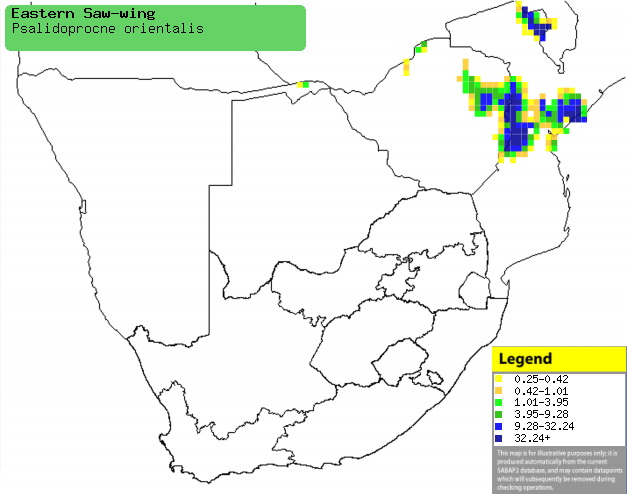|
Psalidoprocne orientalis (Eastern
saw-wing)
Tropiese saagvlerkswael [Afrikaans]; Hirondelle de
Reichenow [French]; Reichenows sägeflügelschwalbe [German];
Andorinha-preta-oriental [Portuguese]
Life
> Eukaryotes >
Opisthokonta
> Metazoa (animals) >
Bilateria >
Deuterostomia > Chordata >
Craniata > Vertebrata (vertebrates) > Gnathostomata (jawed
vertebrates) > Teleostomi (teleost fish) > Osteichthyes (bony fish) > Class:
Sarcopterygii (lobe-finned
fish) > Stegocephalia (terrestrial
vertebrates) > Tetrapoda
(four-legged vertebrates) > Reptiliomorpha > Amniota >
Reptilia (reptiles) >
Romeriida > Diapsida > Archosauromorpha > Archosauria >
Dinosauria
(dinosaurs) > Saurischia > Theropoda (bipedal predatory dinosaurs) >
Coelurosauria > Maniraptora > Aves
(birds) >
Order: Passeriformes > Family: Hirundinidae
Distribution and habitat
Occurs across Malawi and northern Mozambique, with an
isolated population in Zimbabwe and south-central Mozambique. It is by the far
the most common in Zimbabwe's eastern highlands, much more scarce further
north and in central Mozambique. It is also a vagrant to the Caprivi Strip and north-eastern
KwaZulu-Natal. It generally prefers the fringes of forest or woodland, typically
close to open water but also occupying open hillsides, vleis and miombo (Brachystegia)
woodland.
|
 |
|
Distribution of Eastern saw-wing swallow in southern Africa,
based on statistical smoothing of the records from first SA Bird Atlas
Project (©
Animal Demography unit, University of
Cape Town; smoothing by Birgit Erni and Francesca Little). Colours range
from dark blue (most common) through to yellow (least common). |
Movements and migrations
Altitudinal migrant in Zimbabwe with most other
populations resident, although it is scarce in winter.
Food
It eats a variety of aerial insects, usually hawking prey
close to the ground. Most foraging is done at dawn or dusk, sometimes around
noon if the sky is overcast.
Breeding
- Monogamous, solitary nester, although nests can be as close as 10-20
metres apart.
- The nest is slightly inclined burrow, consisting of a 40-80 cm long
tunnel ending in a chamber, where a saucer-shaped structure of lichens and
dry grass is built. It is usually dug into a roadside cutting, stream bank
or any other exposed area.
- Egg-laying season is from September-April, peaking from
October-December.
- It usually lays 2 eggs, which are probably incubated for approximately
18 days.
Threats
Status uncertain, but it is probably not threatened,
although the deforestation is cause for concern.
References
-
Hockey PAR, Dean WRJ and Ryan PG 2005. Roberts
- Birds of southern Africa, VIIth ed. The Trustees of the John Voelcker
Bird Book Fund, Cape Town.
-
Harrison, J.A., Allan, D.G., Underhill, L.G., Herremans, M.,
Tree. A.J., Parker, V. & Brown, C.J. (eds). 1997. The atlas of southern
African birds. Vol. 2: Passerines. BirdLife South Africa, Johannesburg.
|
